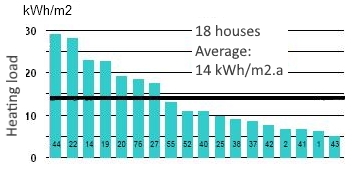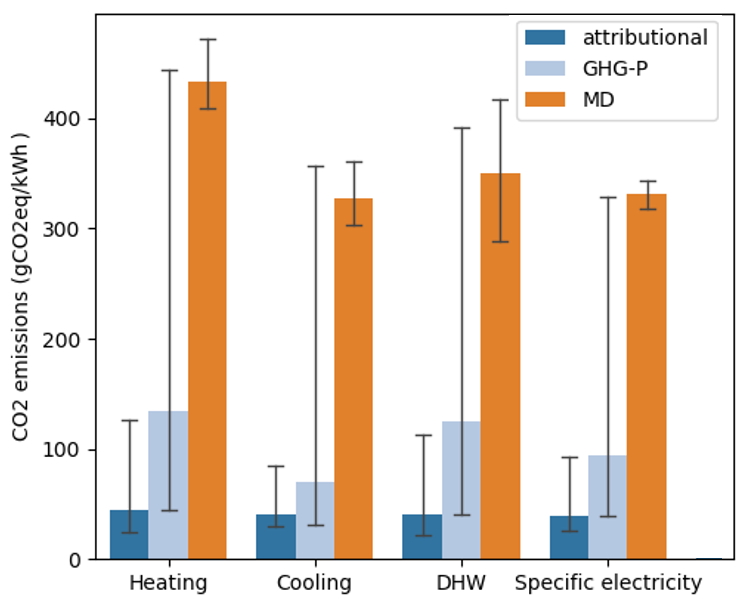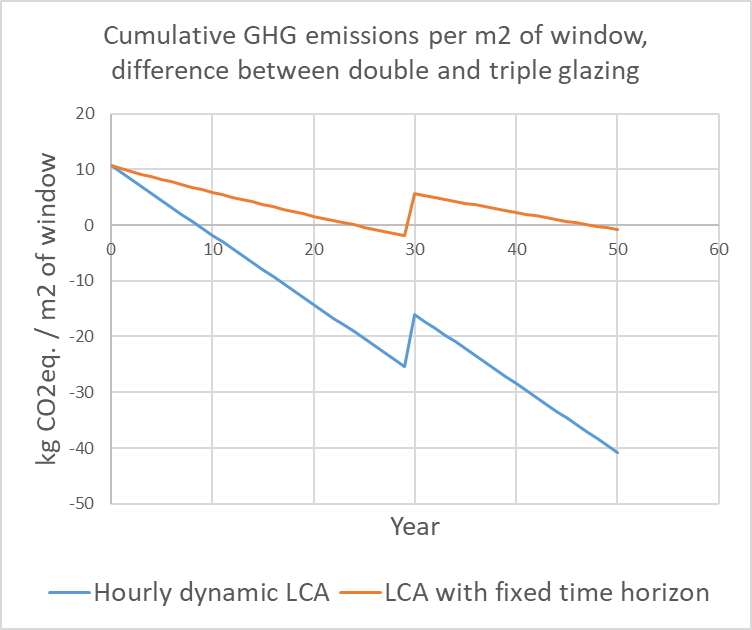
www.buildingsandcities.org/insights/commentaries/cop26-complexity.html
Managing the Long Term and Complexity: Policies for Mitigation
By Bruno Peuportier (MINES ParisTech, PSL Research University, FR)
The longevity of buildings and lengthy roadmaps for a transition stretching to 2050 are misaligned with the urgency to act on the climate situation and the short mandates of elected officials. In this context, dealing with time is complex. Good practice needs to focus on acting and reporting during a shorter period (the electoral cycle) rather than postponing the progress to the next period. Three specific actions are recommended: (1) the need for clear actions, measurement and reporting; (2) policies and regulations must account for complexity and not result in merely shifting impacts; and (3) life cycle thinking.
1. Acting and reporting requires measurement

Much can be learned from monitoring, at any geographic scale, and feedback helps improving road maps. Figure 1 shows the variation in measured heating energy consumption for 18 identical low energy houses in Germany according to the passive house label (Feist et al., 2005).
Measurement is essential to verify the real performance of completed buildings, which can deviate significantly from the calculations. Figure 1 shows that best practice is achieved on average in the case of this exemplary project, and that the actual energy bill significantly depends on occupants' behaviour. This suggests that involvement of citizens is essential in the energy transition.
2. Urgency does not imply haste

Long-lasting artefacts like buildings deserve careful design study, and this is especially true on a global policy scale. A global energy transition policy including consumption and production should be elaborated rather than promoting simplistic strategies. For instance, replacing all oil and gas boilers with electric heating is simplistic. This will create a very high peak demand in winter during which wind and solar production will be insufficient. Renewable gas (hydrogen or synthetic gas) can be produced when solar and wind resources are abundant, and stored to meet peak demand. Figure 2 shows the large uncertainty about the CO2 content of 1 kWh electricity consumed in France related to different energy transition scenarios and life cycle assessment (LCA) methods (Frapin and Peuportier, 2020). This evidence questions the systematic electrification promoted by some policy makers. GHG emissions may be higher for electric heating than for gas (being 270g CO2eq/kWh) using the GHG protocol (GHG-P) or marginal derivative (MD) LCA methods.
3. Life cycle thinking
Life cycle assessment addresses not only greenhouse gases (GHG) emissions, but a set of indicators related to damage to human health, biodiversity and resources. The aim is to avoid impact shifting, e.g. replacing CO2 emissions with nuclear waste, risk and depletion of resources. This also adds complexity but it is essential for a truly responsible policy.

Another goal of lifecycle thinking is to avoid impact shifting over time. For instance, the forthcoming the French regulation imposes CO2 thresholds on products without accounting for their energy benefit during the use stage. The aim is to reduce GHG emissions during the manufacturing process. But this short-term approach disadvantages longer-term savings e.g. insulation and renewable energy systems. Such an approach will shift impacts to the use stage and therefore is inappropriate: whole lifecycle indicators should be used.
Discounting the impacts of future GHG emissions, as in so-called "simplified dynamic LCA", is also implemented in the French regulation. This creates a debt to future generations and disadvantages energy efficient techniques, as shown in Figure 3. When comparing double and triple glazing, a truly dynamic hourly LCA method (Roux et al., 2016), and an LCA with a fixed time horizon according to the French regulation lead to different results. Using an hourly dynamic LCA, triple glazing reduces GHG emissions by around 40 kg CO2eq/m2 of window over 50 years, whereas it is of no interest when discounting future emissions (LCA with fixed time horizon).
The choice of a simplistic assessment will yield different results - hourly dynamic LCA vs LCA with a fixed time horizon.
4. Conclusions
These examples show the influence that policies and regulation have on technological choices and actual outcomes. To be effective and enable robust progress towards a climate responsive built environment policies and regulation must address complexity and verify actual results. Approaches that are too simplistic are likely to merely shift the impacts. The creation of short-term goals and actions (to augment medium- and long-term goals) are vital to ensure that progress is made.
References
Frapin, M. et Peuportier, B. (2020). ACVs Energies - Livrable 5. Etudes de cas et Résultats obtenus. Paris: ADEME. https://librairie.ademe.fr/energies-renouvelables-reseaux-et-stockage/4447-acvs-energies-comparaison-d-approche-acv-des-systemes-energetiques.html
Bühring, A. and Kiefer, K. (2002). Monitoringbericht 2001 zum Förderprogramm Wärmeerzeugung im Passivhaus der EnBW Energie Baden-Württemberg AG. Freiburg: Fraunhofer-Institut für Solare Energiesysteme.
Feist, W., Schnieders J., Dorer V., Haas A. (2005), Re-inventing air heating: convenient and comfortable within the frame of the passive house concept. Energy and Buildings, 37 (11), 1186-1203.
Lab recherche environnement. (2021). L'analyse de cycle de vie dynamique décryptée par les chercheurs. https://www.lab-recherche-environnement.org/fr/article/lanalyse-de-cycle-de-vie-dynamique-decryptee-par-les-chercheurs/
Roux, C., Schalbart, P. and Peuportier, B. (2016). Accounting for temporal variation of electricity production and consumption in the LCA of an energy-efficient house. Journal of Cleaner Production, 113, 532-540. https://doi.org/10.1016/j.jclepro.2015.11.052
Latest Peer-Reviewed Journal Content
Net zero retrofit of the building stock [editorial]
D Godoy-Shimizu & P Steadman
Co-learning in living labs: nurturing civic agency and resilience
A Belfield
The importance of multi-roles and code-switching in living labs
H Noller & A Tarik
Researchers’ shifting roles in living labs for knowledge co-production
C-C Dobre & G Faldi
Increasing civic resilience in urban living labs: city authorities’ roles
E Alatalo, M Laine & M Kyrönviita
Co-curation as civic practice in community engagement
Z Li, M Sunikka-Blank, R Purohit & F Samuel
Preserving buildings: emission reductions from circular economy strategies in Austria
N Alaux, V Kulmer, J Vogel & A Passer
Urban living labs: relationality between institutions and local circularity
P Palo, M Adelfio, J Lundin & E Brandão
Living labs: epistemic modelling, temporariness and land value
J Clossick, T Khonsari & U Steven
Co-creating interventions to prevent mosquito-borne disease transmission in hospitals
O Sloan Wood, E Lupenza, D M Agnello, J B Knudsen, M Msellem, K L Schiøler & F Saleh
Circularity at the neighbourhood scale: co-creative living lab lessons
J Honsa, A Versele, T Van de Kerckhove & C Piccardo
Positive energy districts and energy communities: how living labs create value
E Malakhatka, O Shafqat, A Sandoff & L Thuvander
Built environment governance and professionalism: the end of laissez-faire (again)
S Foxell
Co-creating justice in housing energy transitions through energy living labs
D Ricci, C Leiwakabessy, S van Wieringen, P de Koning & T Konstantinou
HVAC characterisation of existing Canadian buildings for decarbonisation retrofit identification
J Adebisi & J J McArthur
Simulation and the building performance gap [editorial]
M Donn
Developing criteria for effective building-sector commitments in nationally determined contributions
P Graham, K McFarlane & M Taheri
Reimagining circularity: actions for optimising the use of existing buildings
R Lundgren, R Kyrö, S Toivonen & L Tähtinen
Effective interdisciplinary stakeholder engagement in net zero building design
S Vakeva-Baird, F Tahmasebi, JJ Williams & D Mumovic
Metrics for building component disassembly potential: a practical framework
H Järvelä, A Lehto, T Pirilä & M Kuittinen
The unfitness of dwellings: why spatial and conceptual boundaries matter
E Nisonen, D Milián Bernal & S Pelsmakers
Environmental variables and air quality: implications for planning and public health
H Itzhak-Ben-Shalom, T Saroglou, V Multanen, A Vanunu, A Karnieli, D Katoshevski, N Davidovitch & I A Meir
Exploring diverse drivers behind hybrid heating solutions
S Kilpeläinen, S Pelsmakers, R Castaño-Rosa & M-S Miettinen
Urban rooms and the expanded ecology of urban living labs
E Akbil & C Butterworth
Living with extreme heat: perceptions and experiences
L King & C Demski
A systemic decision-making model for energy retrofits
C Schünemann, M Dshemuchadse & S Scherbaum
Modelling site-specific outdoor temperature for buildings in urban environments
K Cebrat, J Narożny, M Baborska-Narożny & M Smektała
Understanding shading through home-use experience, measurement and modelling
M Baborska-Narożny, K Bandurski, & M Grudzińska
Building performance simulation for sensemaking in architectural pedagogy
M Bohm
Beyond the building: governance challenges in social housing retrofit
H Charles
Heat stress in social housing districts: tree cover–built form interaction
C Lopez-Ordoñez, E Garcia-Nevado, H Coch & M Morganti
An observational analysis of shade-related pedestrian activity
M Levenson, D Pearlmutter & O Aleksandrowicz
Learning to sail a building: a people-first approach to retrofit
B Bordass, R Pender, K Steele & A Graham
Market transformations: gas conversion as a blueprint for net zero retrofit
A Gillich
Resistance against zero-emission neighbourhood infrastructuring: key lessons from Norway
T Berker & R Woods
Megatrends and weak signals shaping future real estate
S Toivonen
A strategic niche management framework to scale deep energy retrofits
T H King & M Jemtrud
Generative AI: reconfiguring supervision and doctoral research
P Boyd & D Harding
Exploring interactions between shading and view using visual difference prediction
S Wasilewski & M Andersen
How urban green infrastructure contributes to carbon neutrality [briefing note]
R Hautamäki, L Kulmala, M Ariluoma & L Järvi
Implementing and operating net zero buildings in South Africa
R Terblanche, C May & J Steward
Quantifying inter-dwelling air exchanges during fan pressurisation tests
D Glew, F Thomas, D Miles-Shenton & J Parker
Western Asian and Northern African residential building stocks: archetype analysis
S Akin, A Eghbali, C Nwagwu & E Hertwich
Join Our Community

The most important part of any journal is our people – readers, authors, reviewers, editorial board members and editors. You are cordially invited to join our community by joining our mailing list. We send out occasional emails about the journal – calls for papers, special issues, events and more.
We will not share your email with third parties. Read more



Latest Commentaries
Building-Related Research: New Context, New Challenges
Raymond J. Cole (University of British Columbia) reflects on the key challenges raised in the 34 commissioned essays for Buildings & Cities 5th anniversary. Not only are key research issues identified, but the consequences of changing contexts for conducting research and tailoring its influence on society are highlighted as key areas of action.
Lessons from Disaster Recovery: Build Better Before
Mary C. Comerio (University of California, Berkeley) explains why disaster recovery must begin well before a disaster occurs. The goal is to reduce the potential for damage beforehand by making housing delivery (e.g. capabilities and the physical, technical and institutional infrastructures) both more resilient and more capable of building back after disasters.